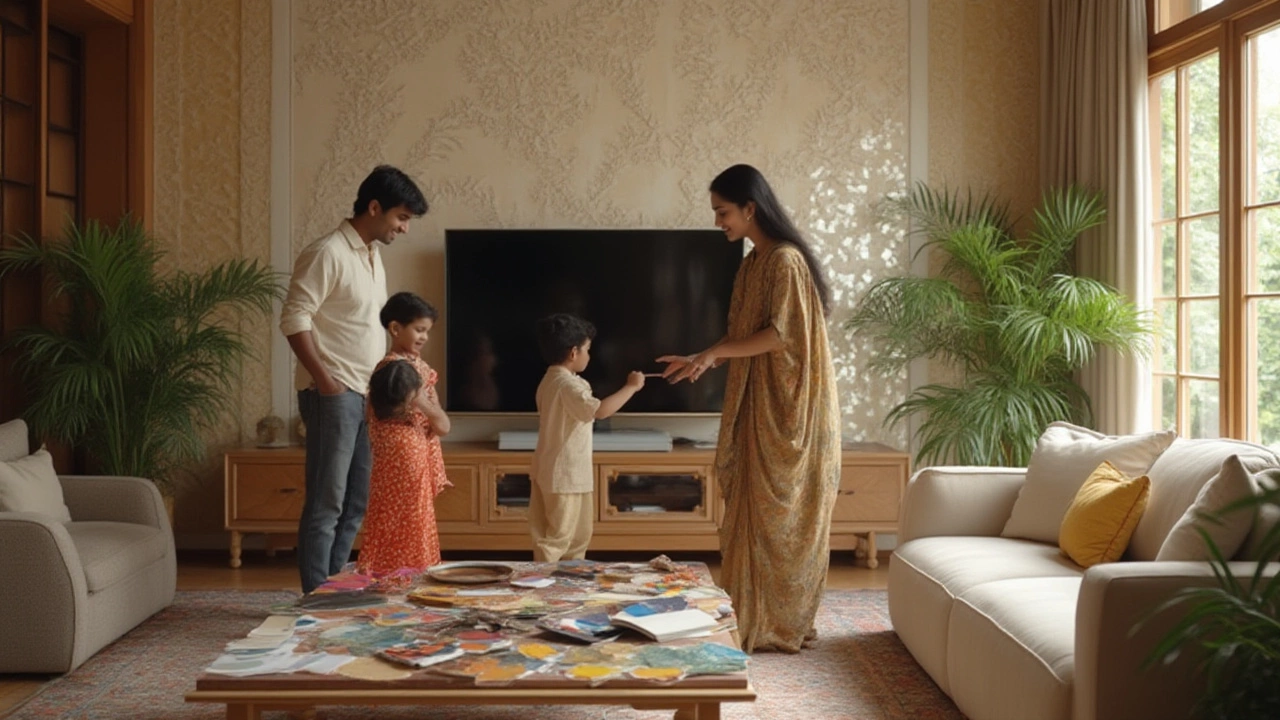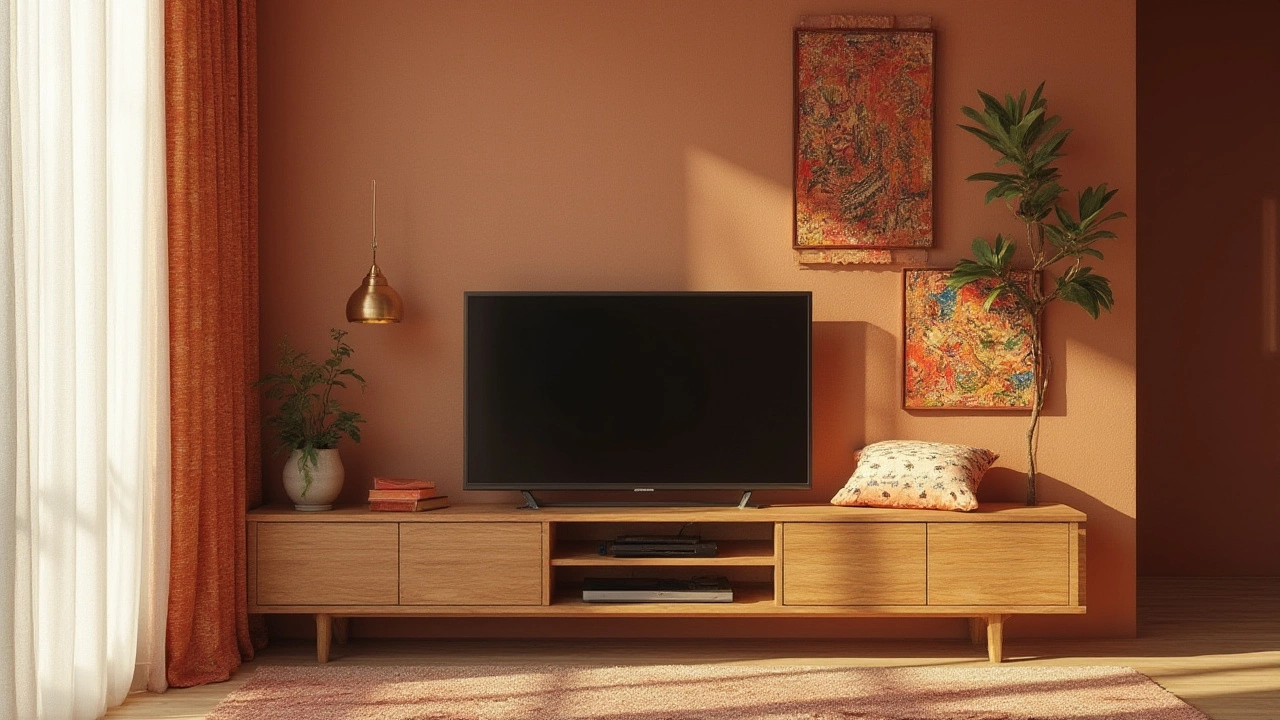Ever feel like your TV stand just doesn’t quite “fit in”? Maybe it looks out of place with the couch, the walls, or even your TV itself. It’s weird, right? Something so simple ends up making or breaking your living room. A lot of people spend hours scrolling through options, staring at the colors, and wondering if a white stand is too plain or if that dark walnut will make the room seem cave-like. There’s a reason designers debate the best color for a TV stand—they get it. The color you pick holds everything together (or makes it fall flat), and it’s not as simple as ‘black or white?’ The right color depends a lot on your style, how light hits the room, what you already own, and, let’s be honest, whether you’re cleaning up fingerprints off glossy black or constantly dusting light wood. Not to mention, in 2025, TVs are huge, rooms have open layouts, and open-plan living means your TV stand gets more attention than ever. So, what’s the best shade for your space?
How Color Impacts Your Living Room Vibe
Let’s start with the big picture: color sets the mood. If you want a relaxed, tranquil space, lighter tones like white, pale gray, or light oak are soothing and help bounce natural light around. They can make a room feel bigger—especially handy if your living room is on the smaller side or doesn’t get much sunlight. On the flip side, going dark with deep browns, black, or navy can turn your TV zone into more of a cozy den, which is great if you watch a lot of movies or just prefer a more intimate vibe. There’s data to back this up: a study by the Interior Design Institute found 67% of people felt light-colored media units made their rooms feel more ‘open,’ while 61% of those with dark TV stands reported they preferred the ‘cinema’ effect they created.
Now, if you love mixing things up, mid-range wood tones like walnut or warm chestnut find a perfect middle ground—neither too stark nor too heavy. These work brilliantly if you’re aiming for that “lived-in but stylish” feel. Plus, real or faux wood grains tend to hide dust, smudges, and the occasional snack-attack stain better than flat colors. You can layer texture and warmth—even with a minimalist palette—by choosing a TV stand in ash, beech, or maple, which pop against darker floors or colorful rugs.
If your taste runs more modern (hello, glass and shiny finishes!), black or glossy white stands are classic. Black absorbs light and frames the TV, making the screen pop and cutting down on glare, which is ideal if you get a lot of daylight beaming through. On the other hand, if your living room has a lot going on—busy wallpaper, patterned curtains—a simple white or pale gray stand can pull everything together without clashing.
Popular TV Stand Colors & How They Work in Real Spaces
Let’s get into the nitty-gritty with real color choices. For decades, black TV stands were the go-to—not just because black ‘goes with everything,’ but because it makes TVs almost disappear, emphasizing the content, not the furniture. Black also helps hide fingerprints but attracts dust, so if you have pets or open windows, be ready to swipe it down every few days. A black stand looks sharp in contemporary lofts or homes with monochrome color schemes.
White is popular with anyone chasing those Pinterest-worthy, Scandi-inspired, or coastal feels. It works wonders in light-starved spaces and plays nicely with pastel throws, light woods, and soft textures. White is a bold move if you have small kids or clumsy friends with red wine, since it can show stains—but on the bright side, it’s easy to paint over later if you change your mind. Most furniture makers now use durable, wipeable finishes, so white stands are way easier to keep clean than they used to be.
Gray is having a moment right now, much like gray sofas and paint. From cool slate to warm taupe, gray works like a chameleon. It’s neutral but less stark than white or black, and it looks sophisticated with almost everything—plants, metallic accents, or bold wall art. A soft gray is less likely to be a dust magnet, and if your TV is mounted above the stand, the gray draws just enough attention to the unit without distracting from the screen. This makes it the MVP in most style guides for modern apartments.
Wood finishes hit different, especially since the mid-century style boom. Oak remains a classic—clean, understated, and easy to blend with both vintage and ultra-modern decor. Walnut is darker, more dramatic, and a staple in homes where you want a timeless look that never screams “trendy.” Many people love reclaimed or rustic woods for a relaxed, organic vibe. These stands age with character, showing off nicks and dings as part of their story. Light woods suit Scandinavian rooms or breezy spaces; darker woods build visual weight and warmth in larger, more formal living areas.
Of course, bold statements are on the rise too. Emerald green, navy blue, or even blush pink TV stands are starting to show up in high-design homes featured on Instagram and in style magazines. You have to commit to these—there’s no hiding a teal TV stand—but if you want the stand to be a focal point, strong colors can totally shift a room’s personality. Pro tip: if you rent or don’t want a permanent change, try contact paper or peel-and-stick wraps to experiment without regrets.

Tips to Match Your TV Stand Color to Your Decor
If only picking were as simple as “choose your favorite color.” For starters, look at your flooring—matching or contrasting your TV stand can change the feel. A dark stand on a dark floor? Dramatic, maybe too much if your room is small. Light stand on a dark floor? Instant lift. While it might seem like mixing woods is a no, design experts say a mix of light and dark tones looks way more interesting than everything matching exactly. The trick is having at least two items (like a coffee table or bookshelf) in a similar tone elsewhere, so the room feels purposeful rather than random.
Wall color is the next big player. If you’ve got dark walls, a white or pale TV stand pops and adds balance. Light walls? Go darker or add some warmth with wood. Got wallpaper or wild accent walls? Neutral colors—white, gray, or natural wood—anchor the room, so things don’t get visually noisy. Another expert hack: match the stand’s tone to a subtle color in your rug or cushions—that way, it always feels intentionally chosen. And in open-plan spaces, connect the TV stand color to your kitchen or dining furniture for a seamless look.
Next, check the material of your TV stand. High-gloss stands look high-end but highlight every fingerprint—especially in black and navy. Matte finishes and wood grains forgive a lot and make the room feel a bit softer. If you’re outside the “messy hands” years, glass shelves look sleek but collect dust fast. Want hidden storage for games, remotes, and chargers? Go with opaque doors in darker colors; clear glass or open shelves make for more frequent straightening up.
Lighting is often forgotten but totally changes how a color looks. A TV stand that looks plain in store could look amazing under the warm glow of your lamps at home—or vice versa! If you shop online, compare how the finish looks in both daytime and evening photos, and always check customer reviews for “true to color” comments. Acrylic and lacquered finishes will reflect colored lights at night, so think about what bulbs you use as well.
If your room is crowded with tech—soundbars, game consoles, Alexa, and a tangle of charging cables—a dark or patterned TV stand hides clutter way better than a pure white unit. And those wires? Black is your friend here. Or, use cord organizers and cable boxes in a matching color for a put-together look.
Choosing the Best TV Stand Color for Your Space
So, what color wins? There’s no one-size-fits-all, but most designers agree on the basics: if you want timeless and versatile, pick a wood finish with visible grain, like oak or walnut. If your room leans cool or you’ve got tons of natural light, white or light gray stands feel fresh. If you binge movies, play late-night games, or just want the focus on your screen, dark woods or black stands work best. Feeling brave? Go for a deep color—but balance it with neutral shades elsewhere (think off-white walls or pale floors) so it doesn’t overwhelm.
One interesting trend? People are customizing TV stands with paint or decals. In the last year, there’s been a 250% jump in DIY furniture makeovers according to Etsy stats. That means you can buy a basic stand and turn it into something unique—a forest green stand in a beige room or even a two-tone look, with white shelving and dark doors. Just use furniture-safe paints and finishes, especially if you put hot electronics on top.
Before you buy, grab a paint sample or order a material swatch if possible. Hold it up in the spot where your TV stand will go, and watch how it changes with the light. Ask family or roommates what they think—sometimes a second opinion saves you from style regret. If you’re changing more than just the stand (maybe getting a new sofa or rug too), build a mood board with all your colors together on your phone. If it looks good there, you’re set for real life. And don’t get bogged down thinking there’s only one right answer—rooms evolve, tastes shift, and furniture can be repainted or covered.
The best color for a TV stand is the one that makes you relax when you flop on the sofa, fits your space, and feels easy to live with day to day. Start with your favorite—whether that’s a sleek black stand, a light wood classic, or an out-there emerald green—and build the room around it. A TV stand often isn’t the main event, but the right color is the secret sauce that makes your space work, no matter if you’re hosting a Marvel marathon or just scrolling TikTok in fuzzy socks.

